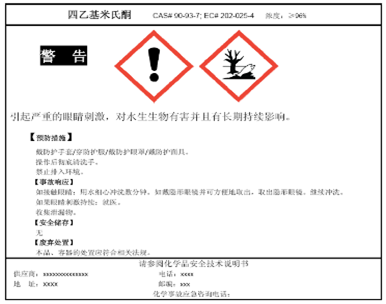In China, the overarching regulation governing GHS and SDS is State Council Decree No. 591- Regulations on Safe Management of Hazardous Chemicals (2011). Under Article 15 and 37 of Decree 591, companies involved in the manufacture, import, storage, use, distribution and transportation of hazardous chemicals are required to obtain and maintain SDS(s) and GHS labels for their chemical products. Penalties for non-compliance, are specified under Article 78, and are composed by the competent authority.
China is a country adopted UN GHS by building block approaches. Chinese government has published several compulsory national standards (starting with GB) and recommended national standards (starting with GB/T) regarding classifications, safety data sheet (SDS), labeling and packaging for chemical products as following.
Classifications
16 Oct 2013, the Standardization Administration of the People's Republic of China (SAC) published 28 new GHS classification standards for chemicals and the implementation date is 1 November 2014. The new compulsory national standards (GB 30000-2013) for chemical classifications are fully aligned with UN GHS Rev. 4 and have adopted all building blocks under UN GHS Rev. 4 including aspiration hazards and hazards to the ozone layer.
The Compulsory National Standards (GB 30000.2-29-2013) for chemical classification in present.
|
Standard GB 30000.2-29-2013 |
Name: Safety rules for classification and labeling of chemicals for |
To Replace |
|---|---|---|
|
GB 30000.2-2013 |
Explosives |
GB 20576-2006 |
|
GB 30000.3-2013 |
Flammable gases |
GB 20577-2006 |
|
GB 30000.4-2013 |
Aerosols |
GB 20578-2006 |
|
GB 30000.5-2013 |
Oxidizing gases |
GB 20579-2006 |
|
GB 30000.6-2013 |
Gas under pressure |
GB 20580-2006 |
|
GB 30000.7-2013 |
Flammable liquids |
GB 20581-2006 |
|
GB 30000.8-2013 |
Flammable solids |
GB 20582-2006 |
|
GB 30000.9-2013 |
Self-reactive substances and mixtures. |
GB 20583-2006 |
|
GB 30000.10-2013 |
Pyrophoric liquids |
GB 20585-2006 |
|
GB 30000.11-2013 |
Pyrophoric solids |
GB 20586-2006 |
|
GB 30000.12-2013 |
Self-heating substances and mixtures |
GB 20584-2006 |
|
GB 30000.13-2013 |
Substances and mixtures which are in contact with water emit flammable gases |
GB 20587-2006 |
|
GB 30000.14-2013 |
Oxidising liquids |
GB 20589-2006 |
|
GB 30000.15-2013 |
Oxidising solids |
GB 20590-2006 |
|
GB 30000.16-2013 |
Organic peroxides |
GB 20591-2006 |
|
GB 30000.17-2013 |
Corrosive to metals |
GB 20588-2006 |
|
GB 30000.18-2013 |
Acute toxicity |
GB 20592-2006 |
|
GB 30000.19-2013 |
Skin corrosion/irritation |
GB 20593-2006 |
|
GB 30000.20-2013 |
Serious eye damage/irritation |
GB 20594-2006 |
|
GB 30000.21-2013 |
Respiratory or skin sensitization |
GB 20595-2006 |
|
GB 30000.22-2013 |
Germ cell mutagenicity |
GB 20596-2006 |
|
GB 30000.23-2013 |
Carcinogenicity |
GB 20597-2006 |
|
GB 30000.24-2013 |
Reproductive toxicity |
GB 20598-2006 |
|
GB 30000.25-2013 |
Specific target organ toxicity- single exposure |
GB 20599-2006 |
|
GB 30000.26-2013 |
Specific target organ toxicity-repeated exposure |
GB 20601-2006 |
|
GB 30000.27-2013 |
Aspiration Hazard |
- |
|
GB 30000.28-2013 |
Hazardous to the aquatic environment |
GB 20602-2006 |
|
GB 30000.29-2013 |
Hazardous to the ozone layer |
- |
The English version of the above national standards regarding GHS is also available in CIRS, please clickhere to know more information.
Safety Data Sheet Standards
The most important national standard related to Safety Data Sheet (SDS) in China is "Safety data sheet for chemical products: content and order of sections" (GB/T 16483 -2008). This recommended standard was published in June 2008 and entered into force in February 2009. It specifies the structure, content and format of Safety Data Sheet in line with China GHS.
The other important standard isGB/T 17519-2013 "Guidance on the compilation of safety data sheet for chemical products", which was issued in September 2013 and came into force on 31 Jan 2014. This recommended standard provides detailed guidelines for SDS authoring in China.
Please note that 24h emergency telephone number is mandatory required for the SDS(s) and labels of hazardous chemicals in China. It must be a domestic landline number in China which can provide directly Chinese launguage supporting and techinical suggestions for emergency issues.CIRS works with the National Registration Centre of Chemicals (NRCC) to provide this service.
Labeling and Packaging Standards
China released 2 main national standards related to the labeling and packaging of chemical products in line with GHS in 2008 and 2009.
The first mandatory national labeling standard (GB 15258-2009) “General rules for preparation of precautionary label for chemicals” came into force on 1 May 2010. Examples of precautionary labels, transport symbols, and precautionary statements for different categories of chemicals are given in this standard. The transition period is between 1 May 2010 and 1 May 2011. There are some differences between this standard and CLP regulation.
-
Black frame of a pictogram is also acceptable(for domestic use ONLY);
-
Simplified label is available for volume <0.1L;
-
No requirement on the minimum size of a pictogram;
-
There is no limit of 6 p-statements;
-
Emergency number on the label must be a domestic 24h mergency telephone number.
The second mandatory national standard (GB 190-2009) -“Packaging Labels for Dangerous goods" is based on the 15th revised edition of the UN recommendations on the Transport of Dangerous Goods. This standard specifies the requirements of pictogram, label size, color and packaging of hazardous goods. This standard came into force on 1 May 2010.
A sample of Chinese GHS label can be found below:

Our Service
-
Free chemical regulatory compliance advice
-
Free chemical inventory search service for Catalog of Hazardous Chemicals
-
Preparation of SDS and labels in accordance with China GHS standards
-
Updating/translating your SDS into Chinese
-
Support to chemical classifications and labeling in China
-
24h emergency telephone service(working with NRCC)
-
SDS and label review